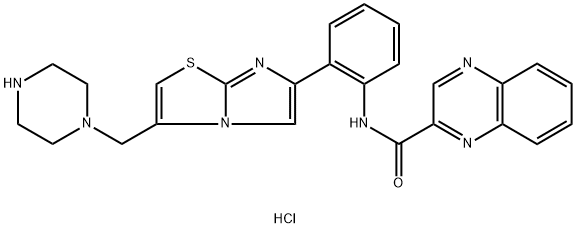
SRT1720
- Product NameSRT1720
- CAS1001645-58-4
- CBNumberCB32512407
- MFC25H24ClN7OS
- MW506.03
- EINECS-0
- MDL NumberMFCD18074509
- MOL File1001645-58-4.mol
- MSDS FileSDS
Chemical Properties
| Melting point | >205°C (dec.) |
| Density | 1.58 |
| storage temp. | = -70C |
| solubility | Soluble in DMSO (>25 mg/ml) |
| form | Liquid |
| color | White |
| Stability | Stable for 1 year from date of purchase as supplied. Solutions in DMSO may be stored at -20°C for up to 3 months. |
| UNSPSC Code | 12352200 |
| NACRES | NA.77 |
SRT1720 Price
| Product number | Packaging | Price | Product description | Buy |
|---|---|---|---|---|
| Sigma-Aldrich 5.30748 | 10MG | $264 | InSolution SRT1720, HCl - CAS 1001645-58-4 - Calbiochem A 25 mM (10 mg/650 μl) sterile-filtered solution of SRT1720, HCl in DMSO. |
Buy |
| Cayman Chemical 10011020 | 1mg | $39 | SRT 1720 (hydrochloride) ≥98% |
Buy |
| Cayman Chemical 10011020 | 5mg | $126 | SRT 1720 (hydrochloride) ≥98% |
Buy |
| Cayman Chemical 10011020 | 10mg | $210 | SRT 1720 (hydrochloride) ≥98% |
Buy |
| Cayman Chemical 10011020 | 50mg | $847 | SRT 1720 (hydrochloride) ≥98% |
Buy |
SRT1720 Chemical Properties,Usage,Production
Description
SRT1720 is a selective SIRT1 activator with EC50 of 0.16 μM in a cell-free assay, but is >230-fold less potent for SIRT2 and SIRT3.In vitro
The maximum activation ratio of SRT1720 versus the closest sirtuin homologues, SIRT2 (EC1.5 = 37 μM) and SIRT3 (EC1.5 > 300 μM) is up to 781%. SRT1720 binds to the SIRT1 enzyme-peptide substrate complex at an allosteric site amino-terminal to the catalytic domain and lower the Michaelis constant for acetylated substrates. SRT1720 could reduce fed glucose levels. Glucose excursion during an intraperitoneal glucose tolerance test is also significantly reduced in the SRT1720 group, and comparable to rosiglitazone, a PPARγ activator that has been used to treat type 2 diabetes. SRT1720 does not have an effect on fasting glucose in chow-fed mice, revealing that pharmacological SIRT1 activation is unlikely to induce hypoglycaemia. SRT1720 significantly reduces the hyperinsulinaemia after 4 weeks, partially normalizing increased insulin levels similar to rosiglitazone treatment. SRT1720 treatment increases mitochondrial capacity by 15% in gastrocnemius muscle as measured by citrate synthase activity. Higher concentrations of SRT1720 (15 μM) induces a modest (10-20%) decrease in normal cell viability. SRT1720 also significantly inhibits VEGF-dependent MM cell migration.In vivo
In DIO mice SRT1720 mimics several of the effects observed after calorie restriction including improved insulin sensitivity, normalized glucose and insulin levels, and increased mitochondrial capacity. In addition, in diet-induced obese and genetically obese mice, SRT1720 improves insulin sensitivity, lower plasma glucose, and increase mitochondrial capacity. Thus, SRT1720 is a promising new therapeutic agent for treating diseases of ageing such as type 2 diabetes. Consistent with improved glucose tolerance, the glucose infusion rate required to maintain euglycaemia is approximately 35% higher in SRT1720-treated fa/fa rats, and the total glucose disposal rate is increased by approximately 20%. SRT1720 also prevents multiple myeloma tumor growth. SRT1720 increases the cytotoxic activity of bortezomib or dexamethasone.References
http://www.selleckchem.com/products/SRT1720.htmlDescription
SRT1720 (1001645-58-4) is a SIRT1 activator (EC1.5 = 0.16 μM, max activation = 781%).1 It reduced glucose levels and hyperinsulinemia in DIO, Lepob/ob mice and Zucker fa/fa rats.? SRT1720 enhanced endurance running and protected against diet-induced obesity and insulin resistance via enhancement of oxidative metabolism in skeletal muscle, liver, and brown adipose tissue.2 It induced mitochondrial biogenesis in oxidant-induced renal proximal tube cell injury.3 SRT1720 repressed circadian clock gene expression and decreased H3 K9/K14 acetylation in a time-specific manner.4 It attenuated angiotensin II-induced atherosclerosis by inhibiting the vascular inflammatory response.5Uses
SRT1720 acts as a therapeutic in the treatment of type 2 diabetes. It modulates calories and contributes to glucose homeostasis and insulin sensitivity.General Description
An enhanced aqueous soluble version of SRT1720 (Cat. No. 567860).Biochem/physiol Actions
Cell permeable: yestarget
SIRT1References
Milne et al. (2007), Small molecule activators of SIRT1 as therapeutics for the treatment of type 2 diabetes; Nature 450 712 Feige et al. (2008), Specific SIRT1 activation mimics low energy levels and protects against diet-induced metabolic disorders by enhancing fat oxidation; Cell Metab. 8 347 Funk et al. (2010), SRT1720 induces mitochondrial biogenesis and rescues mitochondrial function after oxidant injury in renal proximal tubule cells; J. Pharmacol. Exp. Ther. 333 593 Bellet et al. (2013), Pharmacological modulation of circadian rhythms by synthetic activators of the deacetylase SIRT1; Proc. Natl. Acad. Sci. USA 110 3333 Chen et al. (2015), The Sirt1 activator SRT1720 attenuates angiotensin II-induced atherosclerosis in apoE-/- mice through inhibiting vascular inflammatory response; Biochem. Biophys. Res. Commun. 465 732Preparation Products And Raw materials
SRT1720 Supplier
Global(173)Suppliers
| Supplier | Tel | Country | ProdList | Advantage | |
|---|---|---|---|---|---|
| +86-(0)57185586718 +86-13336195806 |
sales@capot.com | China | 29730 | 60 | |
| 008657128800458; +8615858145714 |
FandaChem@Gmail.com | China | 6399 | 55 | |
| +undefined-21-51877795 | ivan@atkchemical.com | China | 33025 | 60 | |
| +86-0371-86658258 +8613203830695 |
sales@coreychem.com | China | 29866 | 58 | |
| 0086-13720134139 | candy@biochempartner.com | CHINA | 965 | 58 | |
| +1-631-485-4226 | inquiry@bocsci.com | United States | 19552 | 58 | |
| +86-023-6139-8061 +86-86-13650506873 |
sales@chemdad.com | China | 39894 | 58 | |
| 8485655694 | sales@alchempharmtech.com | United States | 63687 | 58 | |
| +8618523575427 | sales@conier.com | China | 49732 | 58 | |
| +1-781-999-5354 +1-00000000000 |
marketing@targetmol.com | United States | 32159 | 58 |
SRT1720 Spectrum
1001645-58-4, SRT1720Related Search
- N-[2-[3-(1-Piperazinylmethyl)imidazo[2,1-b]thiazol-6-yl]phenyl]-2-quinoxalinecarboxamide
- N-(5-((5-(4-Acetylpiperazine-1-carbonyl)-4-methoxy-2-methylphenyl)thio)thiazol-2-yl)-4-(((3,3-dimethylbutan-2-yl)amino)methyl)benzamide
- N-[(1R)-1-(Aminomethyl)-2-[(3S)-tetrahydro-2H-pyran-3-yl]ethyl]-N-methylcarbamic acid tert-butyl ester
- MK-8617
- N,N'-[1,2-Ethanediylbis(oxy-2,1-phenylene)]bis[N-(carboxymethyl)glycine 1,1'-bis[2-(octyloxy)ethyl] ester
- N-BOC-cis-4-fluoro-L-proline
- MG-132
- N-(8-Benzyl-8-azabicyclo[3.2.1]oct-3-yl-exo)-2-methylpropanamide
- N-Boc-3-piperidineacetic acid
- N-(Methoxymethyl)-N-(trimethylsilylmethyl)benzylamine
1of4
PROMPT×
PROMPT
The What'sApp is temporarily not supported in mainland China
The What'sApp is temporarily not supported in mainland China
Cancel
Determine

